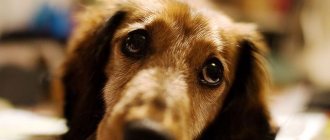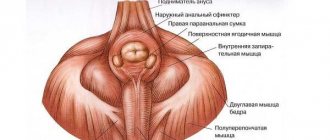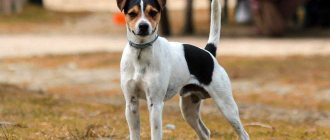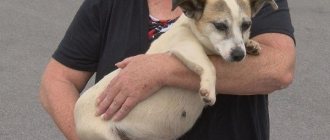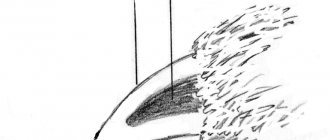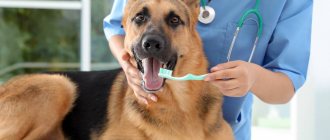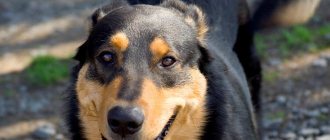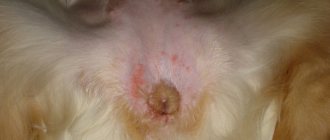What are paraanal glands?
On both sides of the dog's anus, just below its center, there is a pair of organs - the paraanal glands.
They are located under the skin and are not visible from the outside. However, during inflammation, upon palpation, you can feel compactions in the form of tubercles.
Ducts branch off from the glands and end at the sphincter. In terms of structure and principle of functioning, the organ is almost similar to the sebaceous and sweat glands.
How to treat a dog
The secret released during normal operation consists of hormones, and serves as a kind of animal passport. It has a specific smell, individual for each dog. That is why, when getting to know each other, four-legged friends, first of all, sniff each other’s sensitive area.
During defecation, feces mix with the fluid secreted by the glands, letting other dogs know that the territory is occupied.
The secret also serves to attract beautiful representatives of the opposite sex and scare away enemies.
Mixing of secretions with feces occurs only if the animal’s intestines and digestive system are functioning normally. If there are violations in this area, problems begin with the paraanal glands.
Many four-legged pets go their entire lives without diseases in this area, but some animals experience problems.
The sacs become overfilled with secretory fluid, and the animal is unable to clean them on its own. The dog experiences discomfort, and the risk of pathology increases.
Watch the video: Anal glands. Let's understand the problem
Surgical methods of treatment
As a rule, surgical methods are resorted to when the process is prolonged. The gland has become overgrown with fibrinous tissue and the excretory ducts are “overgrown.”
Excision of glandular tissue and removal of the inflamed sac (sacculectomy) is performed under general anesthesia or local anesthesia, depending on the severity of the process.
To remove the entire gland, a special dye is injected and cutting is performed. However, inflamed tissues do not always absorb drugs adequately and the procedure cannot be carried out efficiently.
That is why special attention should be paid to the sanitation of the paraanal glands.
Causes of inflammation of the paraanal glands
Living in natural conditions, each animal must mark its habitat by squirting an odorous liquid from the paraanal glands.
Moreover, such “marking” lasts much longer than similar actions using urine. The secretion of the anal glands is longer washed off by rain and does not erode.
Pets, for a number of reasons, have lost the ability to contract their anal muscles to squirt secretory fluid.
This happened as a result of selection and domestication. Obesity due to improper feeding and low mobility is often the cause.
The accumulation of subcutaneous fat around the anus leads to the dog’s inability to naturally contract the muscles and squeeze out the contents of the paraanal glands.
In this case, secretion accumulates in the gland, the ducts become clogged, and inflammation begins. In severe cases, ruptures occur.
The height of carelessness and inattention to the dog is to let the disease progress to such an extent. If you do not treat your pet, then it is not far from death.
The following factors can cause inflammation of this organ:
- genetic predisposition. More often, the disease is registered in small breeds - French bulldog, Pekingese, Shih Tzu, pug, Spitz, dachshund, etc.;
- pregnancy;
- too frequent matings;
- injuries to the animal followed by bacterial contamination;
- poor nutrition and, as a consequence, incorrect bowel movements (for example, with a large number of bones in the diet);
- inappropriate pet hygiene;
- weak immunity.
Regardless of the specific cause of the disease, the clinical symptoms will be equally unpleasant for the animal.
Cleaning the anal glands in dogs (video)
In what cases is it necessary to contact a veterinarian?
Sometimes a sick dog needs to be urgently taken to the clinic, as delay can be fatal. Here are the cases in which you will need to contact a veterinarian:
- The dog does not eat, does not drink, constantly lies in one position, avoiding moving.
- The dog's abdomen in the rear quarter is very tense and so painful that the pet does not even allow him to be touched. The surest sign of peritonitis!
- The animal's general body temperature rose sharply.
- The dog whines, howls, and licks the genital area all the time.
Algorithm of the inflammatory process in the paraanal glands
As the disease progresses, signs of an inflammatory process in the paraanal glands become more and more clearly visible.
- The normal outflow of secretory fluid is disrupted.
- A large amount of secretion accumulates in the glands.
- The consistency gradually thickens.
- “Sacs” with secretions become visible, their walls become thinner and become painful, causing discomfort to the dog.
- The altered secretion turns into an excellent environment for the growth of strains of pathogenic microorganisms.
- Due to the proliferation of secondary microflora, inflammation becomes even larger, leading to the formation of an abscess and purulent exudate.
- When an abscess ruptures, a fistula forms.
All this leads to other pathologies, so the owner of the animal must carefully monitor the condition of his pet.
Dog diet and feeding
When delving into the problem, the owner should understand that the main thing is feeding. Formed feces, dense, hard, are capable of independently carrying out “sanitation”. The owner must monitor the formation of fecal matter. This is especially true during the period when food is changed or new food is introduced into the diet.
The dog's diet should include:
- proteins;
- fats;
- carbohydrates.
However, carbohydrates come last. The dog is a carnivore. The basis of the diet should be:
- meat and offal;
- bones (pork, beef, poultry);
- dairy products;
- eggs.
It is not correct to think that the listed products are a diet - this is the basis. Take a closer look at the diet; if feces are often not formed, then feeding is not physiological. The food should be reconsidered.
Symptoms of the disease
In order to be fully prepared and not to miss the moment of the onset of your pet’s illness, you need to know the following symptoms and characteristics of the animal’s behavior when sick.
Stage 1
The dog is worried. Always tries to scratch or bite the area under the tail. The pet constantly tries to ride on its butt to scratch this area or get rid of discomfort by licking under the tail.
Be careful and examine what is going on with your pet. The secret is little revealed at this stage. Its color ranges from transparent to yellowish.
Often the owner thinks that his four-legged friend has worms and carries out deworming. But therapy will not help if such behavior is not caused by parasites.
Stage 2
The secretion becomes noticeably thicker, its quantity is even smaller. New signs of the disease appear - hair falls out on the tail and at its base, and pustules and vesicles (rash) appear on the skin of the inner thighs.
The dog will experience stiffness in the movements of its hind legs. At this time, the secretion is actively absorbed into the blood, and the animal begins to lick the skin.
Stage 3
The secretory fluid takes on a creamy consistency, its quantity decreases sharply, and the color becomes even darker. The dog itches more and more, the itching intensifies, and a neurological syndrome occurs.
At this time, contamination with pathogenic and putrefactive bacteria continues, the entire gland and nearby tissues become inflamed.
Stage 4
The secretion turns into a clay-like, granular substance. Color ranges from dark brown to black. The part of the body below the waist can be paralyzing.
Instructions for use
If the sacs are not immediately freed from the thickened secretion, an abscess will form. Once ripe, the abscess breaks out through the skin near the anus. This usually occurs closer to the tail, forming a temporary fistula.
The most severe period of the disease begins. The dog experiences severe pain when bowel movements, when walking and even at rest.
Body temperature rises significantly. If it comes to blood poisoning, then up to 40°. Death is inevitable in the absence of proper treatment.
After opening the abscess, the pet’s condition improves. At this time, the owner notices traces of pus on the fur and under the tail of the animal. After this, while maintaining the excretory ducts, the situation stabilizes.
But more often, with abscesses, the ducts become permanently overgrown with connective tissue, and the disease becomes chronic. The fistula will recur again and again.
During the course of the disease, other changes occur in the dog. Her habits may change and she becomes aggressive. The pet eats little, or even turns away from the food bowl.
During examination, the dog feels pain around the anus, at the base of the tail and in the space between the testicles and the anus. When feeling the body, the owner observes that the animal’s skin and fur are wet.
The disease is accompanied by hardening of the skin (hyperkeratosis). The dog reacts nervously to touching the skin, demonstrating hypersensitivity. Erythema (redness) appears on the skin throughout the pet’s body, gradually turning into erosion.
The patient has a sharp rise in temperature, chills and fever. At the same time, he almost continuously scratches the itchy places under his tail.
The area near the anus becomes noticeably swollen and the animal suffers severe pain. As a result of this entire process, the patient experiences depression, loss of strength, lethargy and constant fatigue.
At the first stage of the disease, your pet can be helped without resorting to medical help. The anal glands need to be cleaned. It would be correct to do this procedure for prevention constantly.
Watch the video: How to wash a dog's anal glands?
Possible complications
Inadequate treatment can have serious consequences. It is likely that an abscess or fistula will develop, the treatment of which will be difficult and painful for the dog.
An abscess is a swelling on the side of the anus. Please note that:
- it represents significant masses of pus in the sacs;
- the pet almost constantly experiences acute pain;
- this occurs both during bowel movements and at rest.
If the pus ducts become overgrown with connective tissue, a fistula is formed. This is a small or medium-sized hole in the dog's skin and other tissues. Pus constantly leaks out through it.
In such a situation, the pet feels very bad. He may lie and whine constantly. Body temperature increases. Together with other symptoms, this is very dangerous for the dog's health. There is a possibility of sepsis - an infectious blood infection. Therefore, it is necessary to contact a veterinarian as early as possible, bypassing the stage of complications.
How inflammation of the paraanal glands is treated in the clinic
Failure to clean the dog's paraanal glands in a timely manner leads to inflammation. The dog's owner rarely examines the area of the anus, hoping that the dog itself will lick and sterilize with saliva any emerging foci of the disease.
However, this is not always correct. If the owner missed the onset of the disease, and it proceeds latently (hidden), then soon something like an abscess will form, and then a fistula.
This is a very unpleasant situation, since these areas of the dog are very sensitive, and he experiences unbearable pain. The worst thing is if fungal pathogens are involved in the infection. They are difficult to identify and more difficult to treat.
It is inflammation of fungal etiology that most often leads to the formation of a fistula. The pus coming out of the canal has a thick, grainy consistency. The grains are mycelium.
Fistulas are similar to abscesses, but their treatment approach is completely different. Diseases must be distinguished from each other. This can be done by palpating the area around the inflammation.
With an abscess, you can easily detect a cavity shallow under the skin. In the first stages of an abscess, the skin in this area will be tense and the temperature will be elevated. With a fistula, after opening the abscess, the temperature will not rise.
You can also see uneven, “shaggy” edges of the wound when an abscess has opened. The fistula's outlet looks like a volcano with walls made of hardened, healed tissue. Traces of healing are visible along the edges of the abscess, which is never observed with fistulas.
For closed abscesses, the doctor prescribes hot compresses, which are applied until the abscess is completely ripe. After this, the veterinarian will open the lesion, wash it with saline solution and antiseptics.
It is impossible to treat such a complication at home. The veterinarian will excise the affected tissue, suture the wound canal, and eliminate the cause of the formation of the fistula.
The patient will be prescribed a course of strong antibiotics and all the necessary tests will be done, if necessary.
The doctor performs the following procedures:
- Shaves the area around the inflammation.
- Cleans bags mechanically.
- Flushes the sinuses.
- Treats everything that is needed with antiseptics.
- Performs an anesthetic blockade.
- Gives an antibiotic injection.
- Prescribes outpatient treatment.
- Provides follow-up and preventive measures.
It takes a long time to treat inflammation. Therapy will include pain blockades, a course of broad-spectrum antibiotics, and the injection of Levomekol or Cephalexin ointment into the opening of the fistula. And perhaps wearing a special cap so that the dog cannot lick the sore spot.
If the pet licks the fistula, the infection will be locked inside the body and, without finding a way out, blood poisoning may develop.
Clinics of two capitals
How to clean a dog's anal glands at home
These manipulations will not bring pleasant sensations to the dog. Therefore, you should attract an assistant who will hold the pet’s head so that it does not bite and help keep the dog in the desired position.
During the process, you need to talk softly to your pet and calm him down. If the owner is too squeamish and cannot calmly clean the dog’s anal glands, then it is better to consult a veterinarian.
The procedure is not particularly difficult. First, you should purchase Vaseline and sterile rubber medical gloves at the pharmacy. It is better to carry out cleaning operations in the bathroom.
After all, the secretory fluid smells pungent and unpleasant. If it gets on upholstered furniture, it will leave a stain that is difficult to remove, and spoiled air will “hang” in the room for a long time.
How to clean the anal glands in dogs?
If the procedure is carried out with an animal of a large breed, then it is placed in a bath, the tail is raised as high as possible towards the back, and a gloved finger, lubricated with Vaseline, is inserted into the anus.
On both sides, glands are felt that look like dense, elastic balls. Using gentle massage movements, the sacs with secretory fluid are emptied. Do not forget that this gland is a steam gland in a dog; two bags need to be emptied.
After completing the procedure for cleansing the glands, the dog must wash the anus area with soap. Immediately give your pet an anti-inflammatory suppository.
For example, ichthyol or chloramphenicol suppositories to prevent infection. Suppositories are used for 4-6 days, preferably after the animal has had a bowel movement.
This is done by inserting a candle into the anus. To prevent it from coming back out, the anus is pressed with fingers. After a minute, the dog can be released. For small breeds, the candle should be cut lengthwise into two parts with a sharp knife and inserted into the desired place.
This procedure is carried out as needed 1-2 times a year. But some animals need monthly cleaning of the paraanal glands or even more often.
If the dog is very worried during the procedure and whines in pain, this means that there is an inflammatory process and you should immediately contact a veterinary clinic.
If you do not use suppositories after cleaning the glands at home, the inflammatory process will continue. The dog will emit an unbearable odor so that all things in the house and the dog’s fur will become saturated with it.
Even repeated bathing in such cases does not bring noticeable results. Therefore, suppositories are a must to stop pathological reactions in the glands.
Watch the video: Treating a large breed dog
This method is not entirely suitable for small breed dogs. This is easy to do with a damp cloth. The owner's hands should be wearing sterile gloves to protect themselves from possible infection.
A napkin soaked in chlorhexidine should be pressed tightly to the anus and compress the rectal area. The secretion from the gland will remain on the napkin. This method seems simpler compared to the previous one.
However, it does not provide one hundred percent cleansing. Some of the secretion sometimes remains in the sac, causing a relapse of the disease. This especially happens when the secretory fluid has already thickened.
Symptoms of the disease and discomfort in the dog disappear on the second or third day after cleaning. Animals that are prone to inflammation of the paraanal glands should “wipe their butt” with a chlorhexidine wipe after defecation as a preventative measure.
If the breeder and owner does not know how to clean the anal glands in dogs, then it is better to go to see a specialist at a veterinary clinic.
Watch the video: Helping a little dog
Preventing blockage
Sometimes it is impossible to avoid pathology, but following preventive measures is enough to never know how to clean your pet’s secretion bags:
- Walking the dog more often will ensure that the glands are cleansed normally;
- It is worth taking care of your pet’s activity, giving it physical activity more often;
- Another important aspect is proper nutrition; excess protein foods lead to difficult bowel movements; bowel movements should be avoided - diarrhea or constipation; To improve digestion, a dog needs fiber.
Inflammation of the paraanal glands is an unpleasant phenomenon; if you seek medical help in a timely manner, it will not significantly undermine your pet’s health. It is important to take care of your pet and, if necessary, carry out the required cleaning; this will save your pet from discomfort and possible complications.
Removal of paraanal glands in dogs: Saculectomy
In severe cases, when the dog has to clean the paraanal glands every 5-7 days, they are removed.
The operation itself is easy to perform. The doctor makes incisions on each side, brings the sacs out through the resulting hole and removes them.
The procedure consists of a number of steps:
- The veterinarian shaves the dog's tail. This must be done carefully so as not to make scratches that will cause irritation. Particular care is taken with the fold at the tail, which is securely fixed “hair to wool.”
- The surgical site is covered with a sterile napkin. As a rule, it is not recorded. But if necessary, the fabric is attached to the wool with clips.
- First, the surgeon finds the exits of the ducts of the paraanal glands, which are usually located in the fold on the left and right sides of the anus, at the border of the mucous membranes. For a better view of the surgical field, additional lighting is necessary. The brighter the light, the better.
- The area of the anus is swollen; to make it easier to find the second duct, the doctor can use a clamp and slightly spread the fold.
- Having found the exit, the doctor uses tweezers (ophthalmic or surgical) to grasp the wall of the duct in the area of the opening and pull on it.
- Using scissors, the doctor cuts the skin at a distance of 2-3 cm from the duct, trying not to touch the wall.
- After this, the doctor incises with a scalpel the skin that was not cut with scissors, then scrapes with a blade, moving the muscles from the gland duct. The duct is usually 4-5 mm long and ends directly in the gland.
- Next, in order not to tear off the duct, it is picked up under the base by a mosquito.
- This stage is performed especially carefully, since the gland goes into a “bag” to accumulate secretory fluid. The fabric of the bag can be easily cut through. The surgeon should try to scrape the muscles in the area of the gland, not the sac.
- The doctor circularly processes the bag, cleaning it. The walls of the sac do not have blood vessels and are normally light yellow in color.
- Then, using scraping movements, the surgeon moves the sphincter muscles away from the gland sac. When the muscle is not completely retracted and a thin muscle layer remains on the bag, the doctor trims it with the sharp tip of a scalpel. These actions are repeated until the muscle is completely retracted.
- The bottom is cleaned by cutting the fibers in the place where they are attached to the bag.
- After removing the glands, two neat holes remain. In the event of a breakthrough in the gland tissue and secretion entering the wound, the doctor washes the surgical field with a 0.05% chlorhexidine solution.
- At this stage, sutures are placed, most often there will be one suture in the area where the mucous membranes meet the skin.
- The surgical site is often swollen, and the doctor prescribes cold compresses with a decoction of oak bark.
In this case, the tissues of neither the anus nor the rectum are damaged. On the first day, the pet may be lethargic, eat little and reluctantly, and sleep more. This is normal.
The pet is ready to play and run within 24 hours. There is practically no rehabilitation period required. It is important that he can perform the act of defecation independently and painlessly.
In the postoperative period, the injured area should be periodically washed with a weak solution of KMnO4 (potassium permanganate). Most likely, the doctor will prescribe antibiotic injections for 5-10 days.
Since the anal glands are not a vital organ, if it is necessary to clean them frequently, it is better to recommend removing them once and for all. This is more humane than seeing the dog suffer.
After such an operation, the dog needs a diet so that bowel movements do not lead to stretching or tearing of the sutures. The food should be easily digestible.
To facilitate the healing process, your pet needs frequent walks, as he cannot tolerate the urge to defecate for long.
